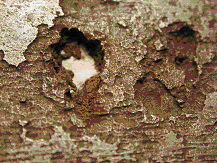| Technical Publication |
Information and Strategy for the
Facility Manager |
|
|
 pdf Version pdf Version
|
|
Treating a Corroded Loop
Mario C. Uy
The most common concern about treating a corroded loop is the fear that it might remove the corrosion (iron) deposits that are holding any holes shut, resulting in leaks.
While corrosion inhibitors are not designed to clean and remove deposits, some inhibitors are formulated with wetting agent and dispersant. The wetting agent helps the inhibitor penetrate any porous and permeable deposits to get to the base metal. The dispersant disperses fine particles so that they do not clump up. By this nature, the inhibitor does have a very small potential to loosen some deposits.
But the fact is some deposits will naturally dislodge eventually on its own regardless of whether the water is treated or not. Even if they remain in place, the existence of corrosion cells (within the deposits) guarantees that the sites will continue to corrode, further weakening the sites, and eventually giving way to leaks. If there aren’t any holes yet, the corrosion cells will guarantee that the sites will continue to corrode until holes are created. So leaving the system untreated would only guarantee a leak eventually.
Corrosion occurs in water loops where the proper corrosive conditions exist and where the loops are not treated against these conditions. Once started, corrosion can sustain itself by creating perpetual differential cells. Within these cells, corrosion accelerates in the form of pitting. Corrosion can also enhance the growth of certain strain of bacteria, which can induce another aggressive form of corrosion commonly referred to as MIC (microbio induced corrosion). Pitting and MIC are very localized and anodic in nature, quickly resulting in a large metal loss, over a small surface area, and over a short period of time. One thing for sure, the probability of leaks increases exponentially with time if the corrosion is left unabated. Whereas, the probability decreases, also exponentially, if the corrosion conditions are mitigated.

An example of MIC Corrosion
Depending on the severity of corrosion, the water loop may benefit from a chemical cleaning to remove any corrosion deposits prior to any treatment. This is akin to prepping a surface before painting. The paint will adhere better to a clean surface. Similarly, a corrosion inhibitor would work better on a clean surface.
Corrosion deposits are deathly detrimental to a water loop. They prevent the inhibitor from getting to the base metal, leaving these areas unprotected. They accelerate corrosion by sustaining their own corrosion cells. Corrosion deposits must be removed to minimize their consequences.
Corrosion is only a symptom. The reason why a water loop corrodes is because there exists certain corrosive conditions, i.e., certain water constituents, bacteria, stray current, galvanic series, high level of dissolved oxygen, etc. All these factors will continue to work together to accelerate corrosion. A corroding loop is a decadent loop. Barring the mitigation of these factors, it is not a question of if, but when will the corrosion problem begin to manifest itself.
Unfortunately, one cannot control the timing of the failure. A failure can happen when you least expect it or when you least cannot afford the timing of its occurrence. So any unexpected failure can have a more catastrophic consequence. For example, imagine a hot water loop springing a leak during subzero degree weather at a midnight on a Saturday. Imagine this snowballing, causing pipe freezing, adding to further toils. Imagine what such a failure would cost you.
Now imagine that you can control the timing as to when you can afford a leak, if it will even happen. Bear in mind that the probability of a leak depends on whether there are any holes that are already existing but are only being kept sealed by the deposits. So if there aren’t any existing holes, the probability of a leak becomes moot. One thing for sure, if you implement the chemical cleaning during any off-peak periods, and you spring a leak, the consequences would be manageable.
When the chemical cleaning is completed, it is imperative that a corrosion inhibitor be applied immediately to passivate the metal surface, to slow down corrosion in the old corrosion cells, and to prevent any new corrosion in the rest of the water loop.
Most likely, not all iron deposits will be removed during cleaning. But the deposits would have been weakened and thus could come apart at anytime. It would be beneficial to install a side stream filter to catch any particles, to prevent them from doing further harm to the loop.
|


